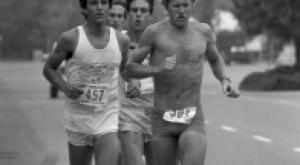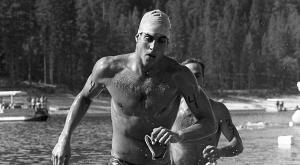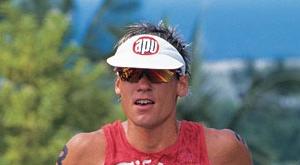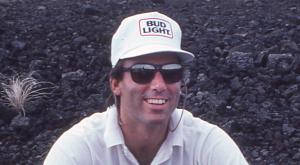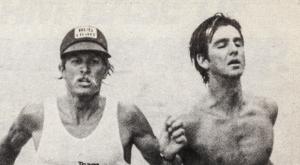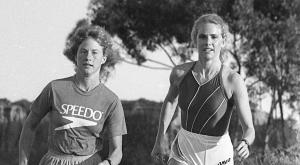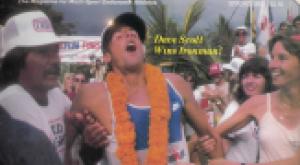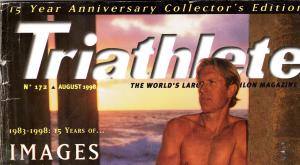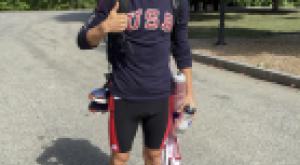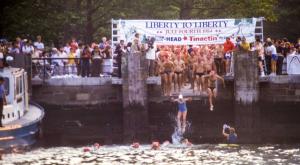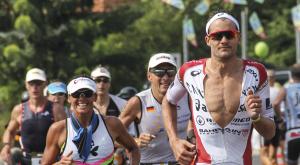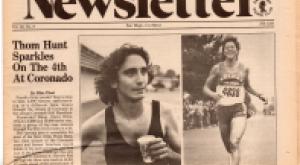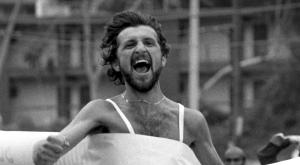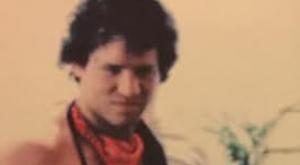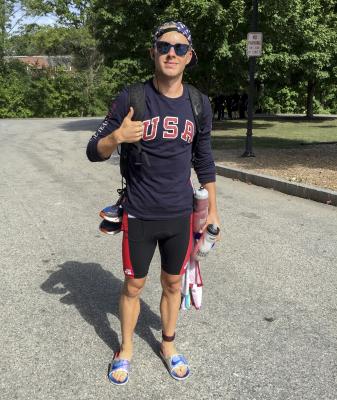
Looking just fine. 2016 USA Olympian Ben Kanue is the epitome of contemporary tri-style -- and the result of four decades of multisport technological evolution, from eyeware to nutrition to everything in between, -- Mike Plant photo
"When the will and the imagination are in conflict, it is always the imagination that wins" -- Emile Coue'
The short history of triathlon might be written in the long search for style. How the sports’ participants sought a certain look, a feel, and a coveted approach to physicality offers a four-decade platform to review how we arrived at 2108 looking so fine. The sport of triathlon, baptized in ‘74 on the boggy shores of San Diego’s Mission Bay, may seem a distant dinosaur when compared to todays’ high-tech hyperbole. Shiny-legged, cartoon and carbon fiber heroes look fast standing still when set against triathlon’s 70s sodbusters. Similarities, however, are found in the quest for both speed and style, for standing beyond the seething masses through a public presentation of parts. From aero bars to body parts, triathletes didn’t just embrace the notion of fashion-as-function. They invented it.
Consider the story of spandex. Once reserved for pool decks and the lessor of drawers, triathlon offered career runners, lifeguards, Navy SEALs, and the fittest of barkeeps to don Lycra Speedos in service of performance with little concern for conservative appearance. Musculature as topographical map signified that triathletes were concerned with moving quickly across aquatic and terrestrial planes… and doing so with panache.
What the one-piece spandex outfit did for triathlon in the early 1980's is analog to what the Colt revolver did for law enforcement in the American West: it enabled the outside public to visualize the capacity of the inner states. A pistol in your hip signified the carrier’s willingness to draw upon that .45 caliber bullet; an imprinted stamp on a changing culture. To show up at a triathlon on Mission Bay in 1982 sporting a spandex onesy was akin to donning a Stetson “Boss of the Plains” cowboy hat on the streets of 1865 Laredo.
Triathletes have always sought to reduce drag. From wetsuits to aero bars to clipless pedals to disc wheels, multisport athletes combined technology with the lack of legislation and discretionary income to create a cottage industry, a candy store for the well-heeled platinum-card crew. Going fast had always been necessary in elite sports. But triathletes made the style of speed de rigueur. The first time I witnessed aero bars was at the Desert Princess Biathlon in the mid-980's. I told fellow pro, Brad Kearns that his bike looked like a sprinkler system. But after he went by me at 30 miles per hour I thought he looked…amazing.

The author, on his way to winning the 1985 Ironman World Championships in Kona. His ST-branded kit that year, his helmet, his bike, all were above-the-line-aero at the time. And crushingly stylish to boot. -- Mike Plant photo
The historic style of triathlon includes the style of rebellion. Whether injured runners from the San Diego Track Club looking for competitive-redemption or average athletes with above-average ability to suffer, early triathletes rebelled against the status quo. For many, the 1970s were a malaise-filled hangover from the vibrant 60s. Not to be denied their revolt, triathletes looked for inspiration in a new athletic experience. Consider Steve Hed’s ground-breaking disc wheels or Jim Jinnard’s Oakley Factory Pilots. While both are steeped in performance and artfulness, their contributions to multisport style are apparent when asking the question of “what’s next?” Because the old ways of doing things were dead. As Hed correctly argued in 1982, “triathlon facilitates an arms race to free speed and freer expression.”
In the 60s and early 70s, runners were scolded for weight training and cyclists were advised not to run. Open water swimmers added body fat for buoyancy and insulation, and football would never, could never be as popular as our American pastime, baseball. Triathlon’s meteoric rise signaled that sport—the last form of popular culture where the ending is unknown—could also be stylishly rebellious, an incubator for new thoughts about athleticism. Food as well, the most essential of human needs, become stylish during the salad days of multisport. We didn’t just drink beer, we drank light beer with a slice of lime. Energy snacks morphed from mushy bananas and PB&Js to malt nut Power Bars. Watery cokes gave way to designer sports drinks engineered to sustain energy, style, and cache.
As the sport unfolded on its own emerging political terms, questions of legislated-style were never far from the surface. Substantive queries such as fairness and balance-in-distances, drafting, gender equality, equipment usage (wetsuits, aero bars, disc wheels, et al.), and Olympic inclusion were all shot through with the challenge of style. Will this help the sport grow in a manner to which we can be accustomed? What will the IOC think about men and women on TV wearing little more than the public’s imagination? How much of my body hair do I need to go fast and look faster? The first time I shaved my body for a triathlon was in February 1982. It was the night before the Ironman in Kona. When I came out of the shower my brother Jeff couldn’t stop laughing. “You look like an egg, Bro.” But in the morning, I felt like a dolphin.
ITU Co-founder and political animal, Les McDonald understood how competitive style gave triathlon an advantage over other sports vying for Olympic inclusion. McDonald argued in 1989 that only draft-legal triathlon would be popular as an Olympic sport. While many purists at the time disagreed, McDonald’s claims that “a peloton roaring by at 40 kilometers an hour is exciting to watch and looks sexy on TV” have largely been supported.
This is not to suggest that triathlon’s primary impetus for growth and maturation were only impacted by a desire to appear attractive to another for extrinsic motives. But whether it be a global audience or a six-packed guy who doesn’t smoke, multisport covet cool.
If we sleuth through the catalyzing elements that brought us to this post-millennial party we all enjoy, we might remember that 40 years ago—and today—triathletes want(ed) to stand apart. If we bust our hump every morning to get out of bed at 5:10AM, make a spin class or meet our fellow aficionados, then why not get some cred for it? Why not wear the skinny jeans and the earned-size? Why not borrow your son or daughter’s clothes?

Lead shot from a fashion feature on Tri-Suits in the June, 1985 issue of Tri-Athlete. Featured were Sylviane and Patricia Puntous and the late Mark Surprenaut.
The traditional sports patriarchy might think differently about multisport’s claim for style-setting. Swimming and cycling in particular were fraught with the burdens of historical culture and bureaucracy that limited equipment, attire, and expression. When Greg LeMond broke out his “secret weapon” to win the 1989 Tour de France by eight seconds, triathletes scoffed. “Yo, cycling industry,” we argued, “triathletes have been using aero bars for three years.”
As we grow older our egos often prevent us from experiencing new situations with innocence and naivete. Society has taught us to exercise caution; to open new doors slowly and never too wide. Perhaps the sport of triathlon during its wild west period offered an adult catalyst to the wild-eyed wonder of youth, a vehicle to explore our physical ideals without threat of judgement or jail. Or maybe we just wanted to look cool and to go fast. The most stylish thing I ever witnessed in the sport was when a full-figured athlete in a post-swim transition stripped herself of a tattered, garage-sale wetsuit. What lay underneath and skin-adhered was a layer of UPS-style bubble wrap. As a casual observer/journalist, I had to ask. “That’s an, uh…interesting choice of insulation.”
“I can’t afford the groovy new eight-millimeter wetsuit.”
“How did you decide to, uh…pack yourself.”
“It’s an art, really. You want just enough on the back end to float your legs but a balanced amount on top to extend the chest, you know…for the aesthetics.”
Triathlon’s collective, living resume is shot-through with anecdotes of experimentation and expression. From Jim Jannard’s Oakley Eyeshades to Jim Gentes’ Giro helmet; from Richard Bryne’s turbo trainer and clipless pedals to Dan Empfield’s bikes and wetsuits named after a Mexican state to Hed’s wheels; from Valerie Silk’s slow-cooked development of the Iron Man to Brian and Jennifer Maxwell’s creation of the sports bar category; to the development of Tri-Athlete and Triathlon Magazines, the sport marches on. And while the current influences are increasingly seen in corporate lockstep, if you know which door to open, the beat remains.
And mostly to a different drummer.


